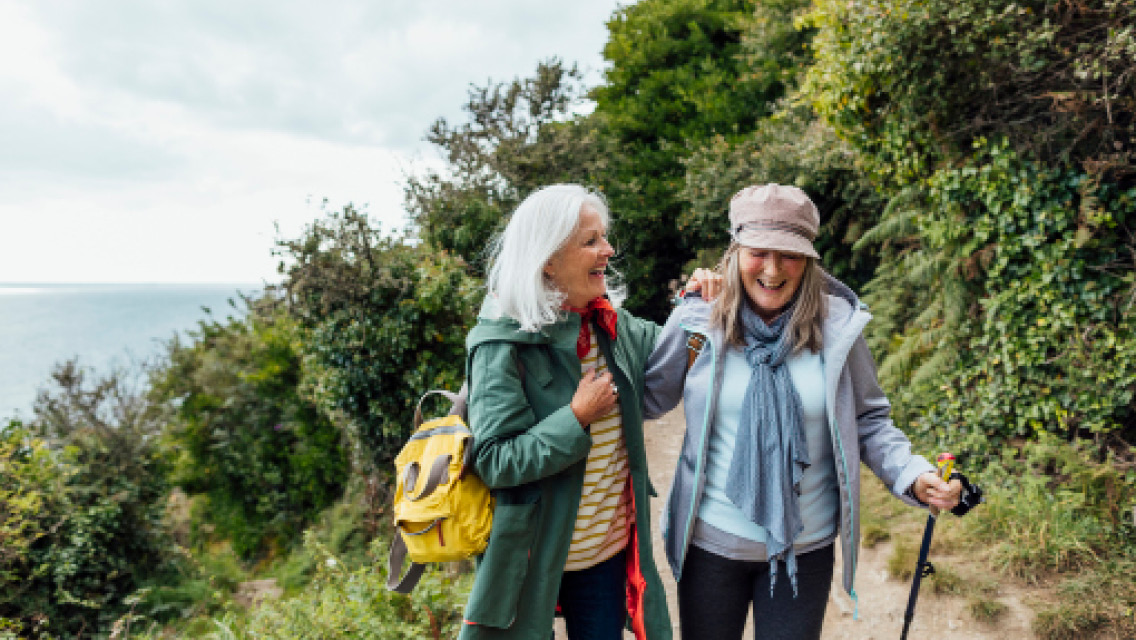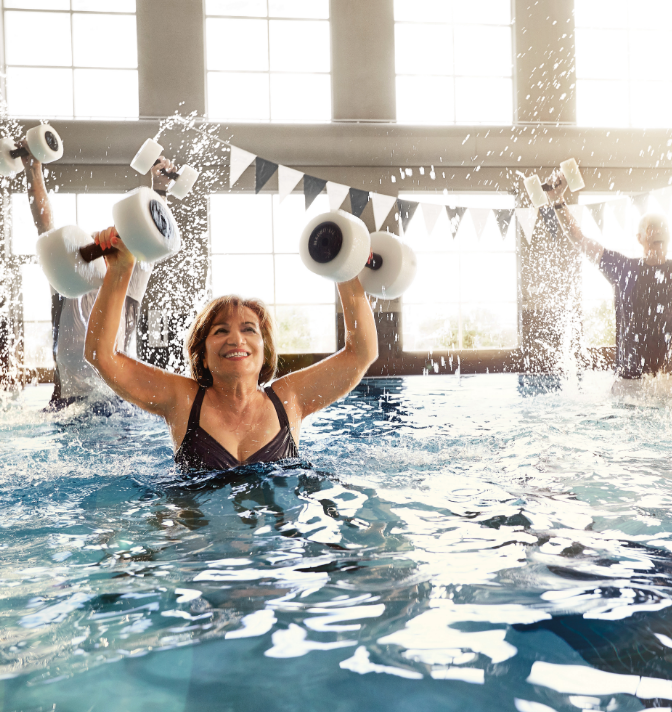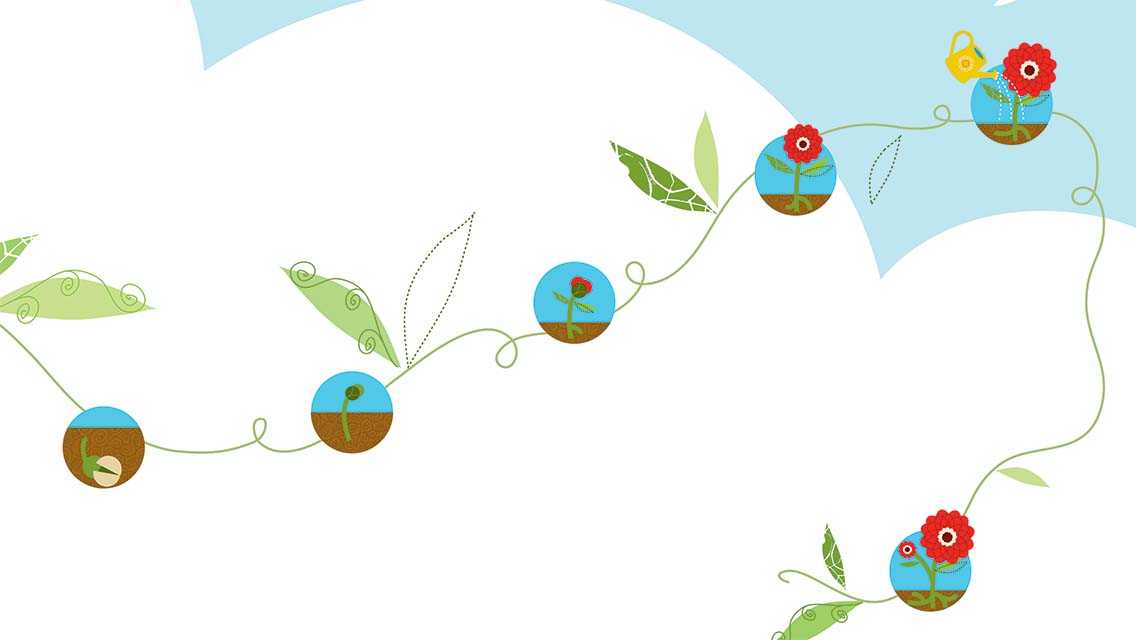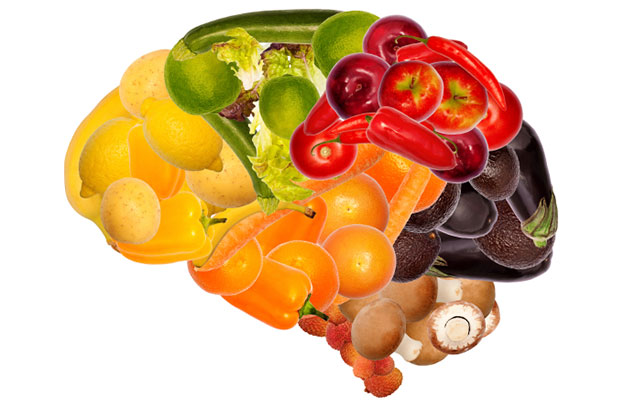Yes, everybody ages. And every body changes. Like it or not, chronologically speaking, when you finish reading this sentence, you’ll be six seconds or so further away from the date on your birth certificate.
In a culture obsessed with youth, the thought that the clock is ever ticking strikes fear in the hearts of many. Uncomfortable with the idea of getting older, many of us live in denial through our 20s and 30s, then do all we can to maintain the appearance of youth in our 40s and beyond. We’ll douse our hair in dye, furiously rub in “antiaging” cream and spend years telling ourselves that we don’t look a day over 29. And, sure, those strategies might calm our fears for the short term, but they help little when it comes to reinforcing the foundations of our health and vitality as the years roll on.
Luckily, research has shown that the pace of the aging process can be influenced — by you. Your chronological age (indicated by the birth date on your driver’s license) does not entirely dictate your biological age (the age you actually look, feel and function at). And, happily, the dimension and character of the discrepancy between those numbers are largely in your control.
By taking some commonsense steps now, you can increase your chances of looking and feeling great many decades hence. You can also decrease the time you spend contending with the ill health, pain and compromised quality of life that too often accompany later years.
Wherever you are on life’s aging continuum, there are proven ways to maximize your physical and mental health and increase not only your chance at a longer life, but, more importantly, the quality of your longevity.
Better Your Biomarkers
We commonly associate the concept of aging with its visible effects, but in fact, the most significant causal factors of aging occur deep within our bodies. Both the causal and symptomatic factors of physiological aging, termed “bio-markers,” have been the object of increased popular interest in recent years, particularly since authors William Evans, PhD, and Irwin Rosenberg, MD, introduced the concept to the public in their best-selling book, Biomarkers: The 10 Keys to Prolonging Vitality.
Hundreds of recognized biomarkers exist in the body (and countless more are likely yet to be identified), and scientists are still not entirely clear on the exact role they play in the aging process. Some, like graying hair and wrinkling skin, appear to be evidence of aging, while others are conditions that actually advance aging by triggering other age-related factors.
Loss of lean muscle (a biomarker), for example, leads to diminished muscle strength (also a biomarker), which in turn increases your body-fat percentage (another biomarker),thereby decreasing resting metabolic rate (biomarker again), which can contribute to compromised arterial health — one of the most important biomarkers of all.
Lifestyle choices can make or break your biomarkers, insist Evans and Rosenberg. No matter what your age, you markedly improve your current health and fitness by taking steps to improve the 10 most significant biomarkers. You can also delay and diminish the time you’ll spend in what the authors refer to as the “Disability Zone” — the years preceding death during which many people suffer invalidism, dependency, frailty and pain.
The best part is, you can upgrade your status in each of the biomarkers (a process referred to as “bio-intervention”) simply by adjusting your daily habits.
Top 10 Biomarkers
- Muscle Mass — The amount of lean muscle tissue on your body.
- Strength — Your ability to support, move and resist weight.
- Basal (or Resting) Metabolic Rate — The baseline rate at which your body burns calories by metabolizing food and tissue into energy.
- Body-Fat Percentage — Your body’s fat-to- muscle ratio.
- Aerobic Capacity — Your body’s ability to process oxygen from the air and move it into your bloodstream and throughout your entire system.
- Blood-Sugar Tolerance — Your body’s ability to control and process glucose (sugar) from food and distribute it via your bloodstream to be converted into energy or fat.
- Cholesterol/HDL ratio — The ratio of LDL (bad cholesterol) to HDL (good cholesterol) in your bloodstream.
- Blood Pressure — The level of pressure exerted by the blood on the walls of the blood vessels.
- Bone Density — The density of the mineral content in your bones. (See “How to Strengthen Your Bones“.)
- Body-Temperature Regulation — Your body’s ability to maintain its internal temperature.
A quick glance at the list confirms that the top biomarkers for healthy aging mirror the expert advice for maintaining physical health at any age. That’s because many of the symptoms we’ve come to associate with growing older (like frailty, weakened immune system, loss of strength) are often less a product of the natural passage of time and more the result of years of chronic physical neglect caused by stress, lackluster eating and sleeping habits, inconsistent exercise, and the like.
Accepting this truth can unearth as many fears and anxieties as it allays. While it’s a relief to learn that the physical decline of aging is not an abstract absolute, it’s uncomfortable to acknowledge the fundamental role we play in the velocity of our own undoing. Essentially, much of what we think of as “aging” is really the compounded result of years of bodily neglect.
Fortunately, healthy-aging experts insist, the opportunities to choose a future of vitality and longevity over decline and decrepitude present themselves to each of us day by day. It’s never too late to start making healthy changes. And there’s no easier way to motivate yourself to make those healthy choices than by directly observing their profound impact on your health right now.
If you want to get a better sense of your current “real age” as indicated by your biomarkers, check out the free health analyses available at www.realage.com. Built on the success of the best-selling book RealAge by healthy-aging guru Michael Roizen, MD, the Web site calculates your real-age number based on 137 biomarkers and other factors that can influence your rate of aging (for details, see “What’s Your True Age?”). The site also offers tailored consumer health information based on your particular set of genes, health history and habits. The fun (or perhaps sobering) part is seeing how the recommended changes could affect your biological age.
Eat Younger Every Day
According to integrative health physician Andrew Weil, MD, the role that balanced nutrition plays in supporting healthy aging cannot be overstressed. As he explains in his bestseller Healthy Aging: A Lifelong Guide to Your Physical and Spiritual Well-Being, many of the biomarker breakdowns associated with aging — from a weakened immune system to cholesterol imbalance — can be attributed to inflammation.
Inflammation is a natural component of the body’s healing system, indicating increased immune activity in an area of the body that is injured or ill. But the inherent power of inflammation is also potentially destructive; too much can cause tissue damage and disease. To regulate the inflammatory process, the body relies on families of hormones that either upregulate (intensify) or downregulate (diminish) it. Food directly affects these hormone levels, either activating or inhibiting internal inflammation.
To encourage the latter, Weil developed the Anti-Inflammatory Diet, a way of eating that he believes will not only reduce your risk of developing age-related illnesses such as cancer and cardiovascular and neurodegenerative disease, but will also support optimum nutrition and overall health, increase energy levels, boost immunity, and even give you better-looking skin and hair.
Here are the basics of Weil’s Anti-Inflammatory Diet (the complete guide can be found in Appendix A of Healthy Aging and is also accessible online to paying members of www.healthyaging.com):
- Eat a wide variety of fresh foods, including lots of fruits and veggies from all over the color spectrum. Avoid processed and fast foods.
- Most adults need to consume between 2,000 and 3,000 calories a day (women and smaller and less active people need fewer calories). Ideal caloric breakdown: 40 to 50 percent carbohydrates, 30 percent fat, 20 to 30 percent protein. Aim to include a balance of healthy carbs, fats and protein in every meal.
- Choose carbs with low-glycemic loads, like whole grains (excluding whole-wheat-flour products), beans, winter squashes and sweet potatoes. Avoid wheat flour and sugar, especially bread and most packaged snack foods (including chips and pretzels).
- Consume fats in a ratio of 1:2:1, meaning one measure of saturated to two measures of monounsaturated to one measure of polyunsaturated fat. Strictly avoid all products made with partially hydrogenated oils of any kind. Good fats include: extra-virgin olive oil, avocados and nuts (especially walnuts, cashews and almonds). Seek out omega-3 fatty acids, available in salmon, sardines, herring, black cod, fortified eggs, hemp seeds, flaxseeds and walnuts.
- Aim for fiber, 40 grams daily. Good choices include fruit (especially berries), veggies and whole grains.
- Drink six to eight glasses of pure water a day. Substitute high-quality green, white or oolong tea for coffee.
Brain Boosters for Life
Scientists once believed brainpower peaked at early middle age. Now they know better. In a January 2006 Time magazine article, writer Jeffery Kluger reported that recent studies have shown that far from slowing down during the course of a lifetime, the aging brain begins to use new cognitive systems and to cross-index existing ones in new ways. At UCLA, for example, neurologists studying myelin, the fatty sheath of connective tissue that helps conduct nerve signals throughout the brain, have found that myelin development peaks in healthy adult brains between the ages of 45 and 50. The scientists postulate that this may allow older brains faster processing and information-retrieval speeds than younger brains, whose myelin stores have yet to fully mature.
In fact, older brains operate quite a bit differently than their younger counterparts, according to neuro- scientist Roberto Cabeza, PhD, associate professor of psychology and brain sciences at Duke University’s Center for Cognitive Neuroscience. He found that older brains increasingly use both the left and right hemispheres of the prefrontal cortex in tandem, rather than working independently of each other, like younger brains do. While Cabeza speculates that this phenomenon may be a trick the brain uses to compensate for age-related cognitive decline, the integration of the hemispheres can sometimes become so efficient that the older brain’s reasoning and thought processes operate better than ever.
Findings like these have led some experts to conclude that the brain at midlife — a stage increasingly defined as the years from 40 to 60 — is far more limber an organ than previously realized. It may even rival the young brain for qualities like temperament, comfort with ambiguity and the ability to interpret meanings.
That’s more support for our “with age comes wisdom” truism. It’s important to note, though, that the brain works a lot like a muscle. The more you use it, the healthier it becomes, say experts like Gene D. Cohen, MD, PhD, author of The Mature Mind: The Positive Power of the Aging Brain, and Sandra Cusak, PhD, and Wendy Thompson, MA, the authors of Mental Fitness for Life. Just as working out helps you stay in top physical shape, mental-fitness routines boost your brain’s power, strength and stamina.
Cusak and Thompson developed their seven-step Mental Fitness for Life course based on current research on cognitive function in the aging brain and their own research with the senior residents of Century House, a 2,100-member recreation center for seniors on the Canadian west coast. No matter your age, whether 33 or 103, insist Cusak and Thompson, by challenging your brain in this way, you can support deft and dexterous brain functioning for years to come:
1. Set Goals: Goal setting has rarely been a focus for personal development work with people over 50, write Cusak and Thompson. But research suggests that those in their “third age” who undertake goals in an entirely new area, such as an untried foreign language or musical instrument, enjoy special brain-boosting benefits.
2. Power Think: “Simply put, power thinking means out with the old beliefs and in with the new,” explain the authors. It can be accomplished by identifying limiting beliefs about yourself, challenging them and replacing them with new beliefs about your potential for limitless growth as you age.
3. Be Creative: New research suggests that people can develop their creativity into later life, say Cusak and Thompson. And creativity is not restricted to just artistic expression: It’s about bringing anything new — from ideas to ways of being in the world — into existence.
4. Accentuate the Positive: Having a positive attitude is critical to healthy brain aging. “Research tells us that optimistic people live as much as six years longer,” says Cusak. Optimism can be cultivated, even by sworn pessimists. By actively working to see the positive in every situation, you can gradually adjust your outlook on life in ways that support both brain and body health.
5. Learn to Remember, Remember to Learn: You can support your memory by adopting the “lifelong learning” approach. “Learning new things causes the dendrites [a component of neurons] to grow and branch wildly, improving brain power,” write the authors.
6. Speak Your Mind: Share your well-earned perspective with others. Consider starting a “conversational salon” or “philosophers’ cafe” in your community.
7. Have a Plan: The final step to ensuring the Mental Fitness for Life plan is having a strong strategy to implement and support the first six steps. The authors advise an ongoing assessment and adjustment approach: “Tailor-make your mental fitness program daily, weekly, monthly and yearly,” they write. “Change it as you change yourself.”
Forget Old Age, Think New Stage
One of the funny quirks about human aging is, statistically speaking, the longer you live, the longer you’re likely to live. For example, a child’s life expectancy increases by the time it reaches its first birthday.
If you’ve made it to late adulthood, the odds of living to a ripe old age are decidedly in your favor. All the more reason to safeguard the quality of those extra years. (For more on that, see the “Into the Wild Blue Yonder” below.)
We now know that the physical and mental decline long associated with aging is less a fated guarantee and more a single outcome in a world of possibilities. “Yes, aging can bring frailty and suffering,” Weil writes in Healthy Aging, “but it can also bring a depth and richness of experience, complexity of being, serenity, wisdom, and its own kind of power and grace.”
Aging gracefully, it seems, requires both pragmatically accepting the aging process and proactively integrating the approaches best proven to maximize health at any age. No, you can’t turn back the clock, and you’re not going to live forever. But by making smart decisions today, no matter how old you are, you can ensure your chance of becoming the person with whom you’ll want to spend the rest of your life.
What’s Your True Age?
According to aging experts, you are, in many ways, as young as the health of your habits. RealAge is a system of measuring your biological age (as opposed to your calendar one) based on 137 factors that can influence your rate of aging. To begin to get an idea of what age you look, feel and function at, answer the following questions (the full assessment is available free at www.realage.com):
- Do you get your vitamins? Regularly taking supplements of vitamin C (1,200 mg/day), vitamin E (400 IU/day), calcium (1,000–1,200 mg/day), vitamin D (400–600 IU/day), folate (400 mcg/day), and vitamin B6 (6 mg/day) can cut six years from your RealAge. Check your multivitamin to see how it compares.
- Do you have a handle on stress? Periods of intense stress can add as much as 32 years to your RealAge. But maintaining good stress-reduction strategies and strong social support networks wins back as many as 30.
- Do you smoke? Smoking adds eight extra candles to your RealAge. The good news? Quitting will knock seven right off.
- Do you listen to your dentist? Daily flossing and brushing cuts 6.4 years from your RealAge. Left unchecked, the plaque on your teeth is the same bacteria that leads to inflammation and clogging of the arteries, while periodontal disease and tooth loss puts your immune system at risk. (Oral health is intricately connected to the rest of the body. See “What Your Mouth Is Trying to Tell You” to learn more.)
- Are you active? Even a small amount of exercise — as little as two 20-minute walks a day — can shave five years off your RealAge.
- Do you get enough fiber? Getting at least 25 grams of fiber a day can make your RealAge 2.5 years younger. (Andrew Weil, MD, recommends as much as 40 grams.) (Fiber performs other key roles that might surprise you, affecting everything from your skin to your gallbladder, heart and immunity. Learn more at “Fiber: Why It Matters More Than You Think“.)
- Do you laugh? It’s no joke — laughing a lot reduces stress, strengthens the immune system and can deduct as many as eight years from your RealAge.
- Do you love to learn? Becoming a lifelong learner can reduce your RealAge as much as 2.5 years.
- Are you current on your checkups? Seeking quality medical care and managing chronic conditions wins you back 12 RealAge years.
- Do you buckle up? Wearing your seat belt and staying within 5 mph of the speed limit can make your RealAge as much as 3.4 years younger.
What’s Your Body Age?
Many health clubs offer members free or low-cost BodyAge assessments in order to help them establish a baseline measurement of several key health and fitness indicators. The assessment provides you with your current BodyAge score, as well as a recommended fitness program. For more info, inquire at your health club or visit www.polarusa.com/healthclubs/healthclubs/bodyage.asp
Into the Wild Blue Yonder
An intrepid explorer studying the world’s longest-living cultures finds that living long and living well are often one and the same.
Centuries of explores have scoured the globe in search of the storied fountain of youth. Minnesota-based extreme adventurer and educator Dan Buettner (see “Forever Young”) believes he’s found it — in the so-called longevity cultures of a handful of long-living communities around the world.
These regions, dubbed “Blue Zones” by Buettner, lead the planet for life expectancy, disability-free life expectancy (a measure of quality of life in old age), or concentrations of centenarians.
Take Sardinia, Italy, where the female-to-male ratio of centenarians is nearly one-to-one (compared to four-to-one in the United States). Or Okinawa, Japan, whose senior residents enjoy possibly the world’s longest life expectancy while suffering just one-fifth of the heart disease, one-fourth of the breast and prostate cancer, and one-third less dementia than their American counterparts.
Backed by such auspicious patrons as the National Institute on Aging, the National Institute of Neurological Disorders and Stroke, and the National Geographic Society, Buettner leads the Blue Zones project, a long-term study of these exceptionally enduring populations. As a key part of his investigative efforts, Buettner also mounts multimedia-savvy scientific expeditions that explore these cultures and populations on the ground and then beam back daily reports and video via satellite.
The interactive Blue Zones Web site lets classrooms of kids get in on the action, and even help direct the expedition as it happens. Best of all, kids can get personally involved in living a healthier life by taking up a BlueZones Challenge designed especially for them.
Traditions to Adopt
Studies have shown that up to 70 percent of how well we age can be attributed to our lifestyle, Buettner says. “We take a look at the lifestyle in each Blue Zone and try to scientifically distill down a longevity recipe that Americans can live by.”
On the Blue Zones Web site, Buettner shares the first of his findings in 10 film shorts created during his October 2005 Blue Zone visit to Okinawa. “Each of the 10 bring to life one of the longevity habits of highly successful centenarians,” he explains. “The habits include things like surrounding yourself with family and friends, living with your parents and grandparents, exploring your faith and spirituality, getting daily exercise, eating a rainbow of colors, finding a sense of purpose, and simply getting married.”
Upcoming Blue Zones expeditions include spots in Central America, Italy and right here in the United States. For more Blue Zones findings and more updates from the frontlines of the world’s longevity cultures (including the newest identified Blue Zone to be announced this October), tune in at www.bluezones.com.





This Post Has 0 Comments